Muscle Body How to Draw
How to depict muscles
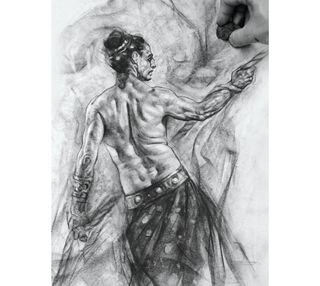
Knowing how to draw muscles in motility will add fluidity and movement into a notwithstanding epitome. This tutorial will report the male dorsum and artillery, exploring the natural rhythm of the muscles, and the expressiveness they brandish when they work in spousal relationship and counter-balance to propel the trunk with grace and fashion.
It's a beautiful thing to observe for someone who loves anatomy, merely information technology opens a whole new world of possibilities for an artist – flowing shapes, lines and rhythmic tones. Mastering how to convey that in a piece will enhance your piece of work.
If you would like to further extend your anatomy cartoon capabilities with more than tutorials, check out our posts on figure drawing, how to depict an arm, and our roundup of the best how to draw tutorials.
Read on for Patrick J Jones' in-depth tutorial on how to describe muscles.
Click on the icon at the top-right of the image to enlarge information technology.
The challenges of beefcake
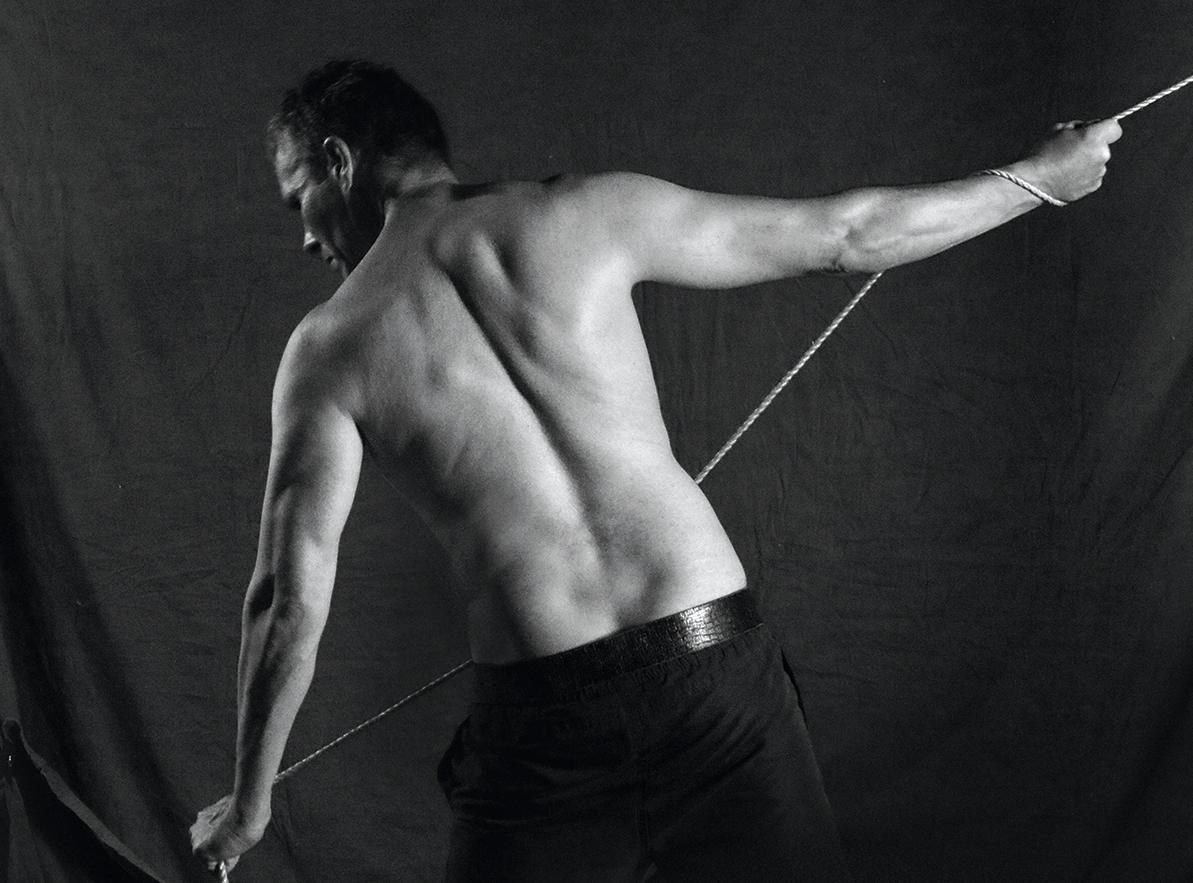
Before nosotros begin the tutorial, a word on anatomy. Anatomy is basically the same for everyone in a non-activeness pose, just the moment we move, the muscles change shape and affect each other equally they jostle and push confronting each other. In other words, muscles are shape-shifters. Add together to the fact that we're all unlike shapes and sizes with different personalities and degrees of expression, and nosotros stop up with unlimited chances for expression using the human being figure.
Await at the fashion a boxer moves compared to a ballerina and y'all'll run across a world of difference in expression of line and tone within what is basically the aforementioned man anatomy. Of class, studies by nature are a notoriously deadening affair, with a studied drawing usually ending up on the strong side.
- The all-time pencils for colouring, drawing and sketching (opens in new tab)

To identify the muscles and their interactions, reference the photos shown here against the Tug-of-War study sheet at the end of the article. My start book, The Anatomy of Style (opens in new tab) , was initially all study sheets documenting my knowledge of anatomy, only then became a more than voluminous volume. Taking those first notes and learning anatomy memory clues and basic structural shapes gradually fed my subconscious and freed me up to depict gesturally.
Unfortunately, I'd not fatigued for a month before this assignment. I'd been in the US for the wonderful 9 show on imaginative realism, where I was giving a lecture on my latest volume, Figures from Life (opens in new tab) , which is about the gesture of anatomy. On that annotation, the all-time mode to counter stiffness borne of outrageous rust is to draw lots of gestural drawings beforehand. Okay, with that said, let's become started…
01. Find the motion in stillness
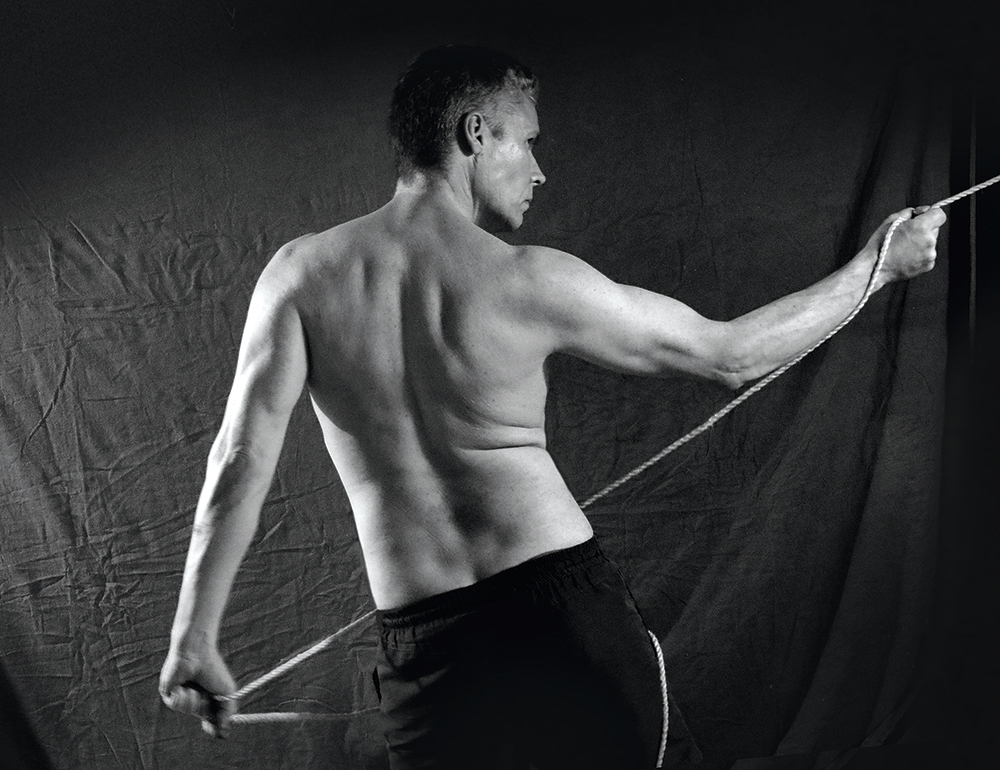
In this photo, the rhythm of life in muscle movement is evident – when we learn to see it. Note the waves created when the rib-cage bites into the side obliques, and the rolling hills running from the shoulder across the raised arm. Here, the trunk suggests movement fifty-fifty in stillness.
02. Search for simplicity
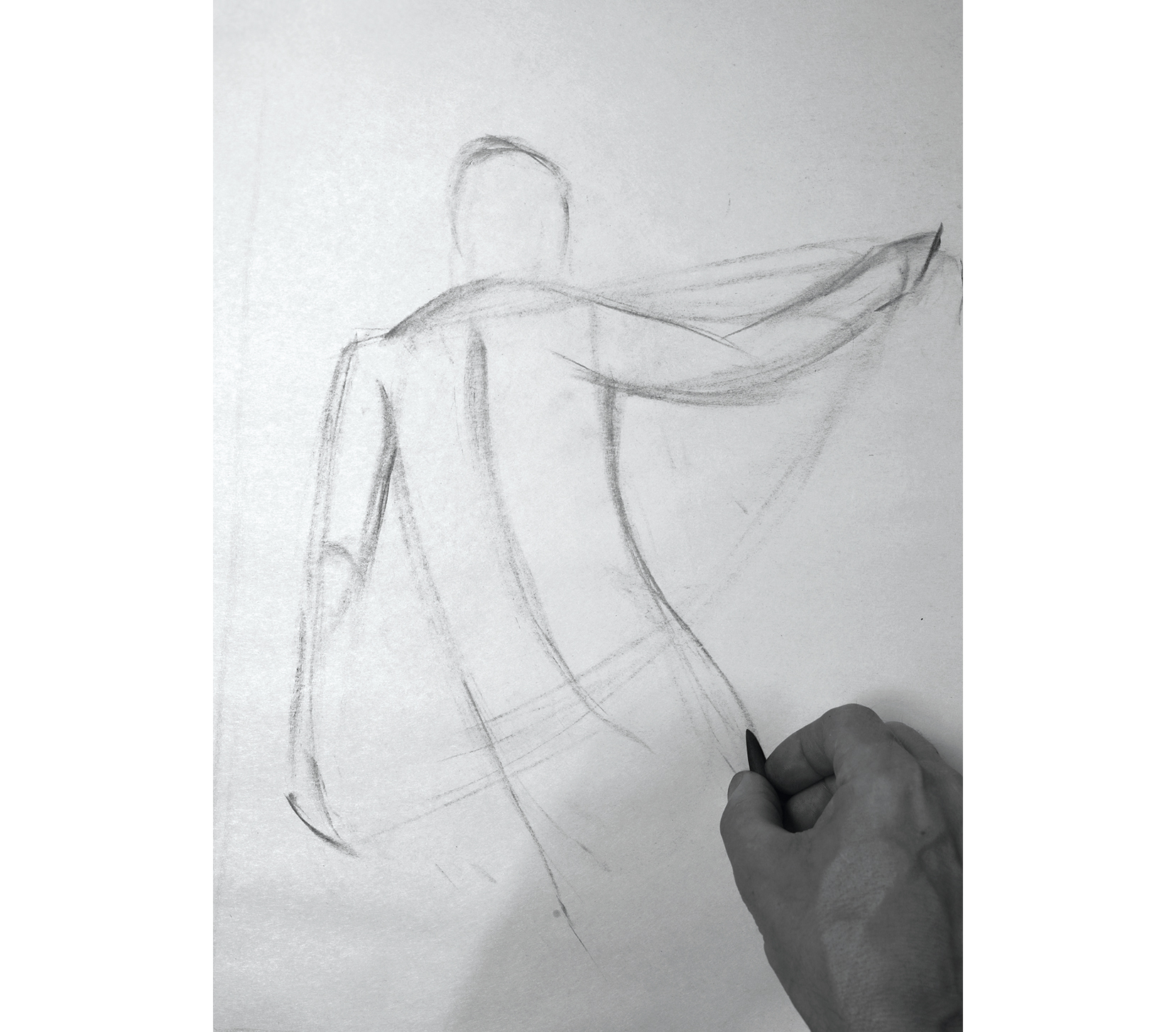
Using my two-finger-wide sharpened charcoal piece, I draw in the simple shapes to begin with. The male person figure is notoriously blocky and I demand to discover as much gesture as I can. Past finding simplicity we can uncover gesture, even in blocks. Remember that gesture is king. If we work only with structure in heed, then our drawings volition be potent. Keep lines long and loose whenever possible.
03. Work the pinch
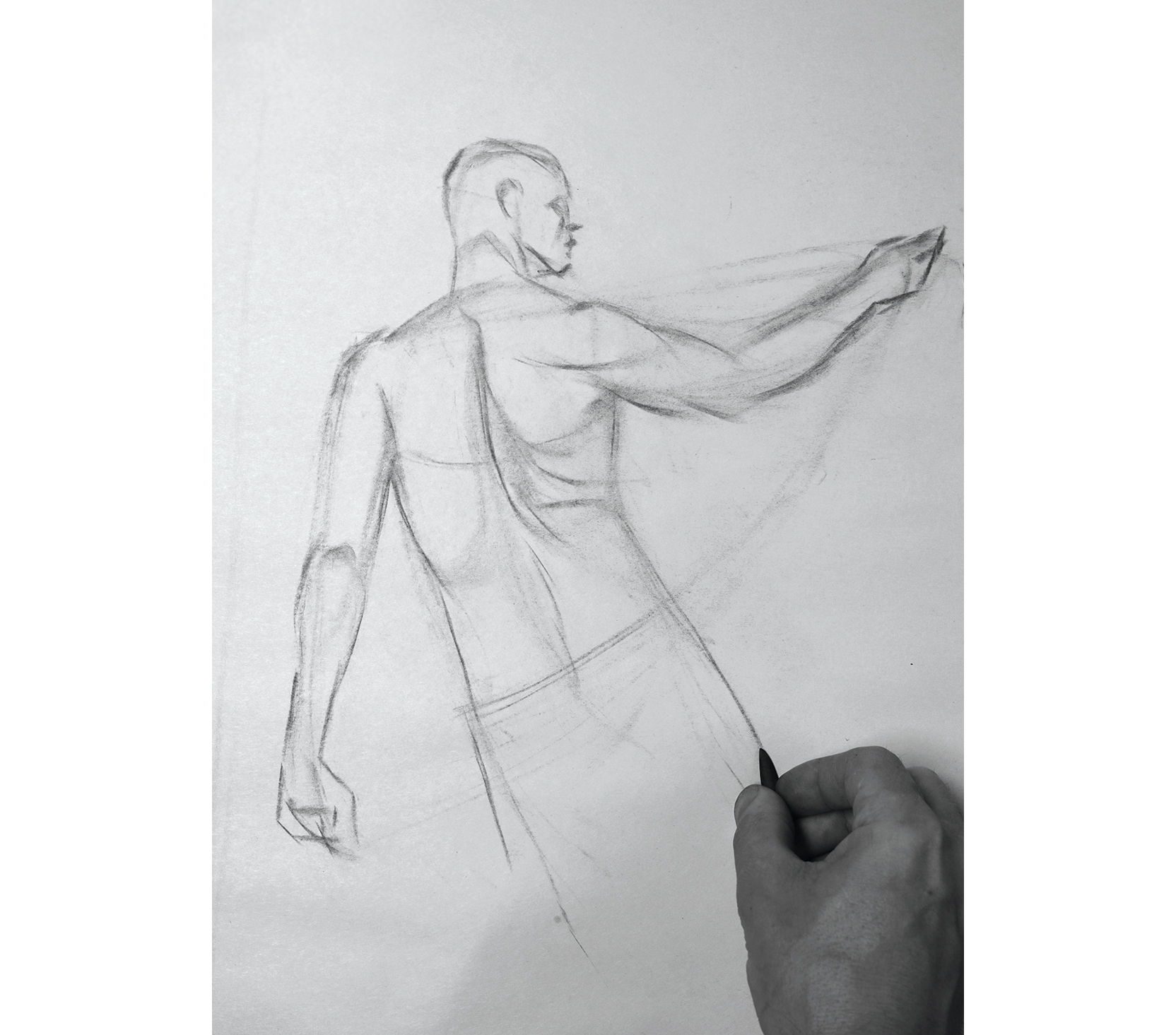
I work on the 'pinched' side of the trunk first because the distances between forms is shorter and easier to guess than on the wider, longer stretch side of the trunk. This is a tip I learned from master draftsman, Steve Huston (opens in new tab). Every bit usual I'one thousand working with simple shapes first, which makes it easier deal with the complexities ahead.
04. Get down the shapes of the musculus blocks
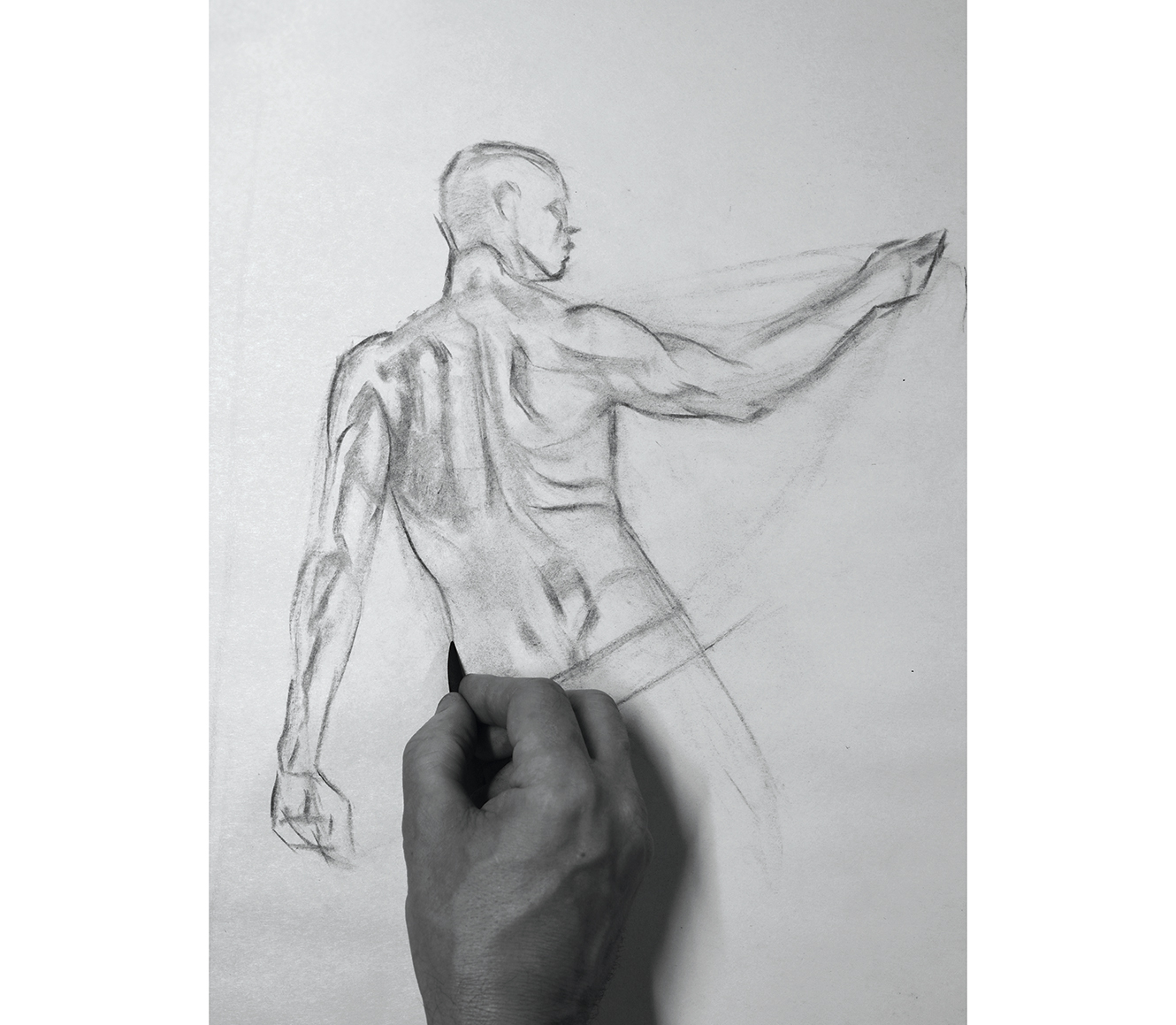
With the cake-in stage by and large complete, I once over again employ the help of gesture to regain some fluidity. Past working from ane muscle to some other it becomes apparent that they share similar shapes at their borders. It'southward fourth dimension to dance and to chase the rhythms of muscle and flesh.
05. Draw with rhythm
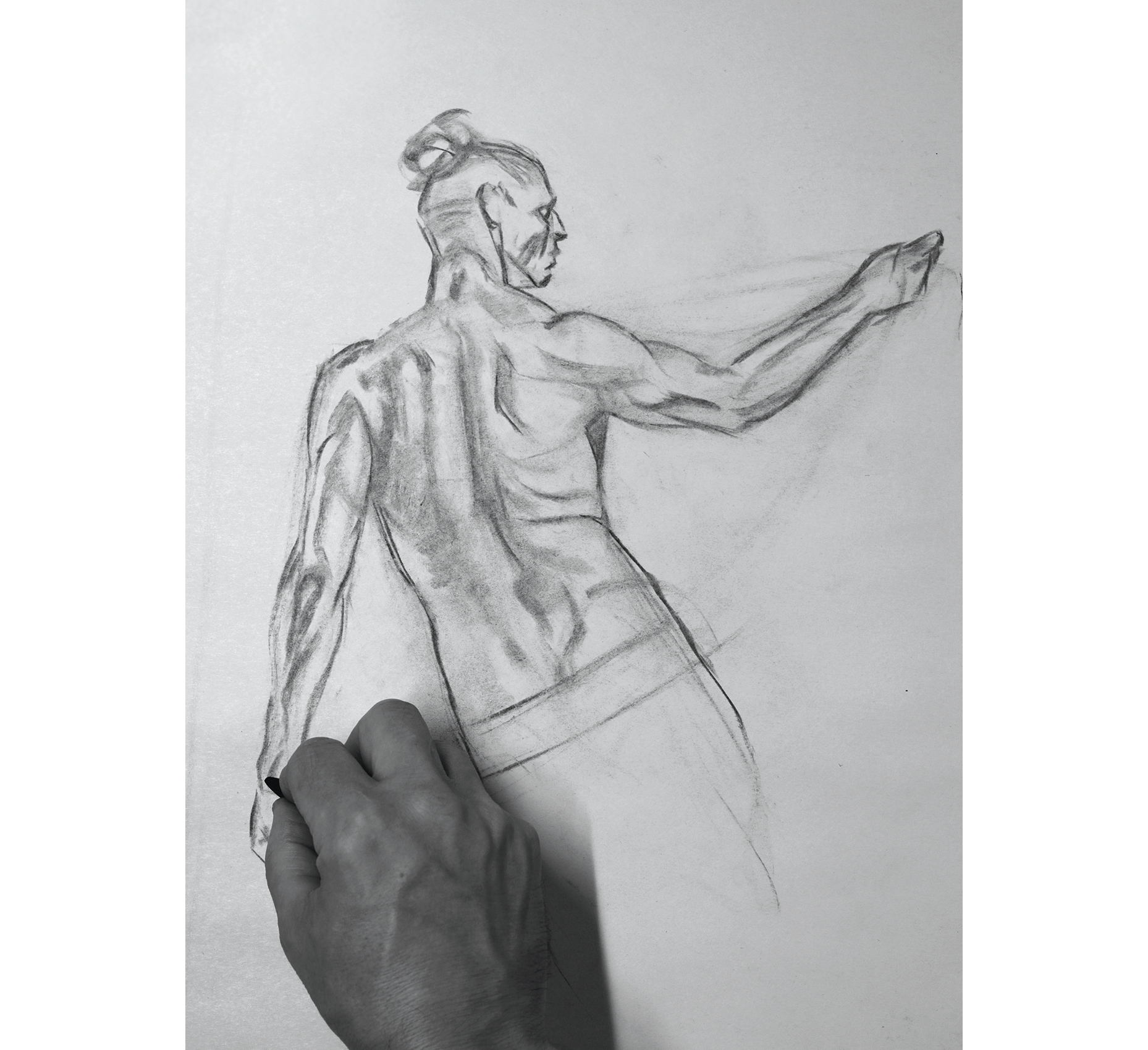
Continuing down the model'south left arm, I proceed the dance by drawing from one side to the other in rhythm. Note the natural menses of things, and how the forearm bulges are higher on the exterior, like much beefcake such as the calves of the legs. I'k chasing rhythms here: left to right, high to depression…
06. Engage the great motivator

I championship the art, The Pearl Fishers, subsequently a piece of opera I first heard equally a immature boy. To become into the mood I play the music as I work and find it a corking motivator with its similar echoes of rhythm and gesture. Next upwards is Madame Butterfly, to really get the passion flowing!
07. Render with rhythm
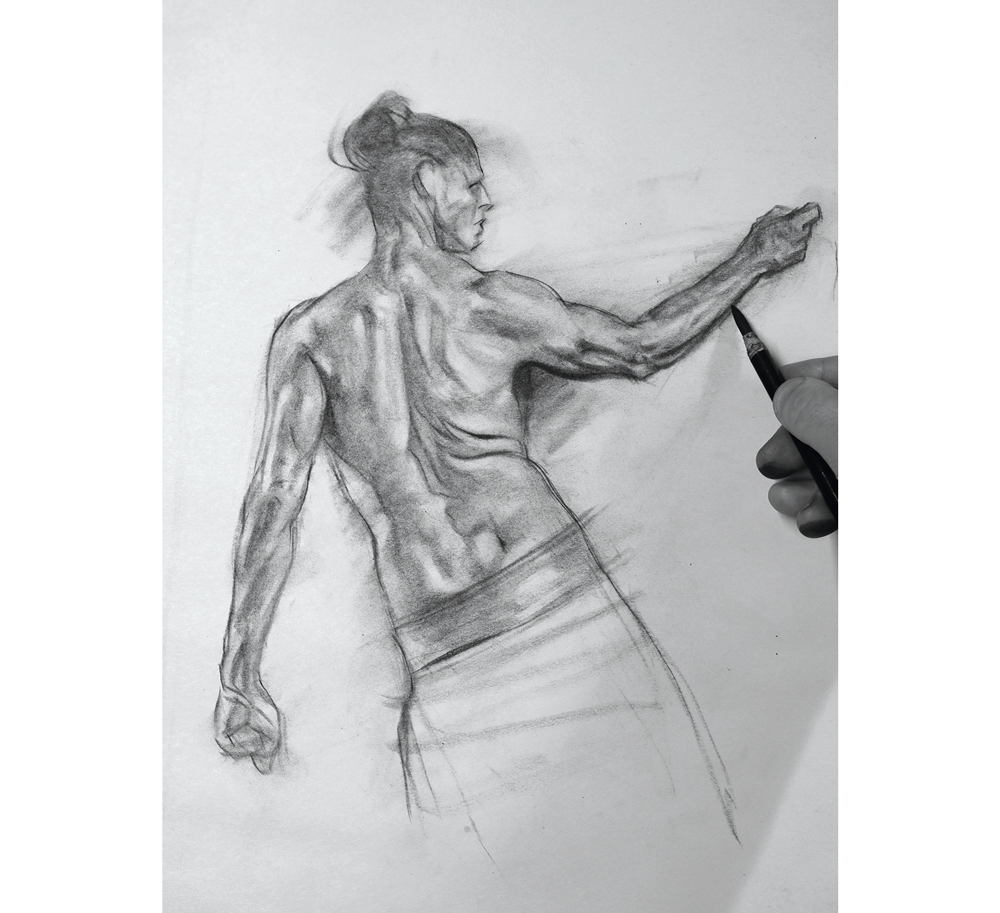
With the rhythms taken care of, I dust the drawing back with tissue to achieve a softer undercoat that I can work the darks and lights out of. I begin rendering the forearm and hand – an area so complex that it'll have its ain workshop – and up into the upper arm, rendering with the same rhythm as before.
08. Realise the ripples and echoes
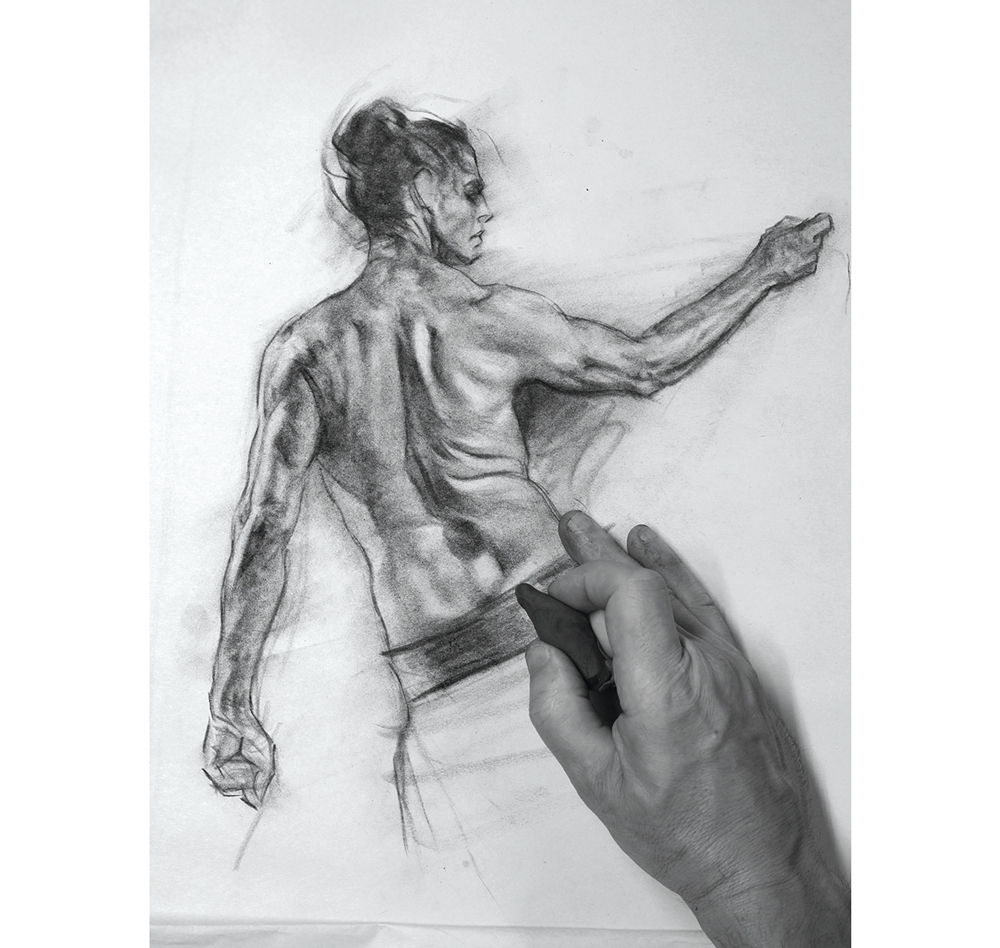
Laying in the darks reveals the nature of muscles pushing into flesh to create ripples. Meet how the scapula pushes into the rhomboid muscles, creating moving ridge-similar echoes all the way down the spine to the sacrum dimples of the hips. All this poesy leads me to draw a sensitive face, such is the power of rhythm.
09. Avoid getting stuck in Render Hell

Nosotros could telephone call the cartoon finished because the more nosotros return, the stiffer a drawing becomes. Only as this is a study I'll go on to draw the minutiae and see if Render Hell raises its ugly caput. I've besides drawn a thicker rope than I posed with in the reference, for added authenticity.
x. Feel the damp touch
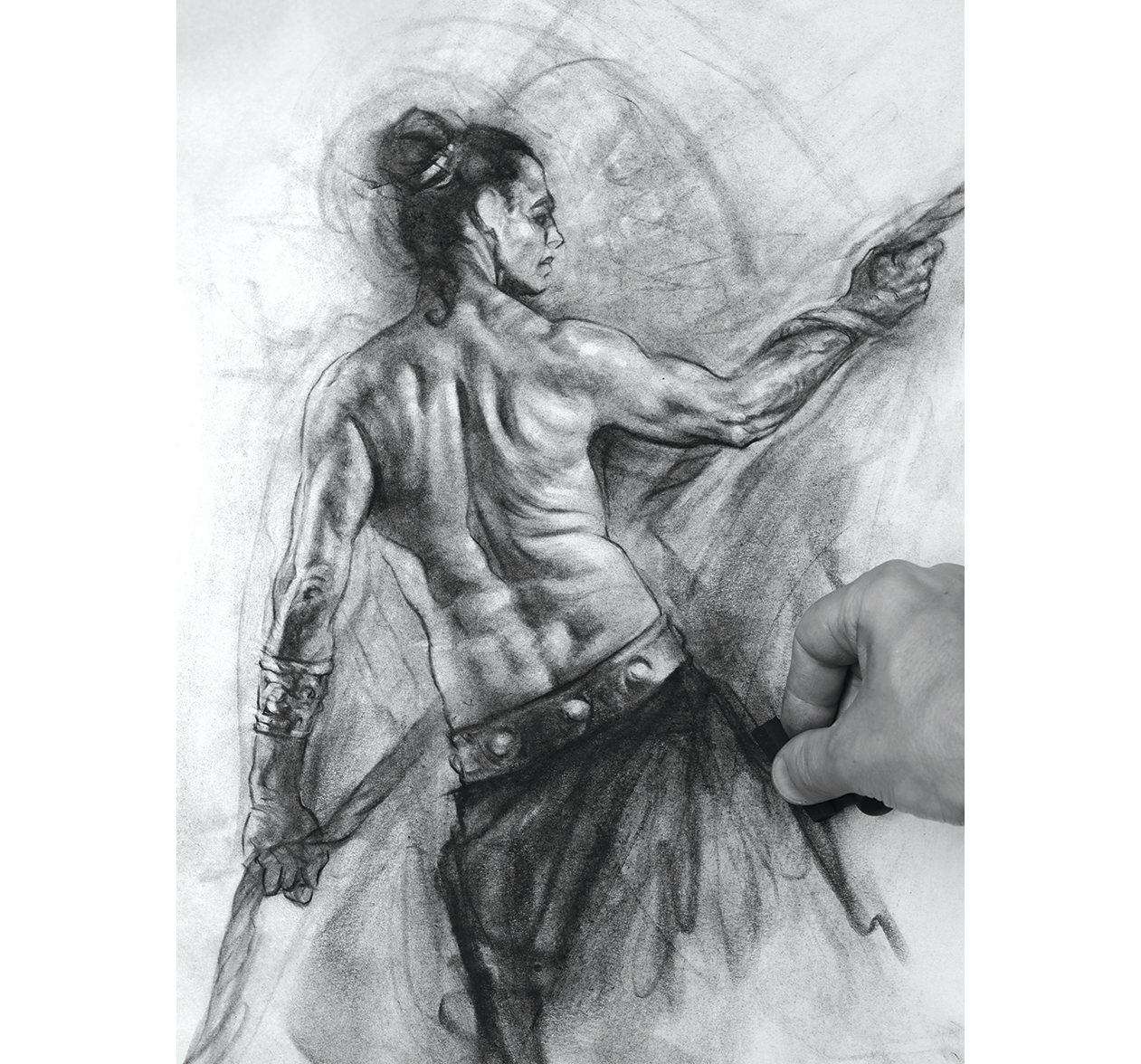
Cartoon the arm bracelet leads me into a stiff corner and feeling the clammy bear on of Render Hell, I take a piece of compressed charcoal and engage my gestural hand again. I likewise add some abstract shapes in the background with willow charcoal for added move.
11. Add together detail to the sarong and adjust the face

I add 'gold' spots to the fisherman's Lavalava sarong with an eraser, which feels a bear on feminine for a fisherman, simply I similar the spots too much to let them go. To counter this, I depict a rugged confront. This may not exist an improvement, but nothing kills creativity more than than the fright of failure, and then I bonfire alee regardless.
12. Admire the beautiful antagonist

I continue highlighting with erasers and detailing with pencils. Annotation the beautiful antagonistic nature of the triceps and biceps of the raised arm as they work in sync. The triceps are lengthening to enable the bicep to contract and shorten. The opposite is happening on the direct arm.
13. Play the long game

As I suspected, the continued rendering has killed a lot of the gestural energy of the before stages. Nonetheless, experimentation wins out when playing the long game, and I'm all in as far as art goes. I swirl effectually some abstract storm clouds to see what happens. There are no mistakes in fine art. You lot just have to call back of every stroke as a learning feel, regardless of the finished cartoon.
14. Behold the shape-shifters
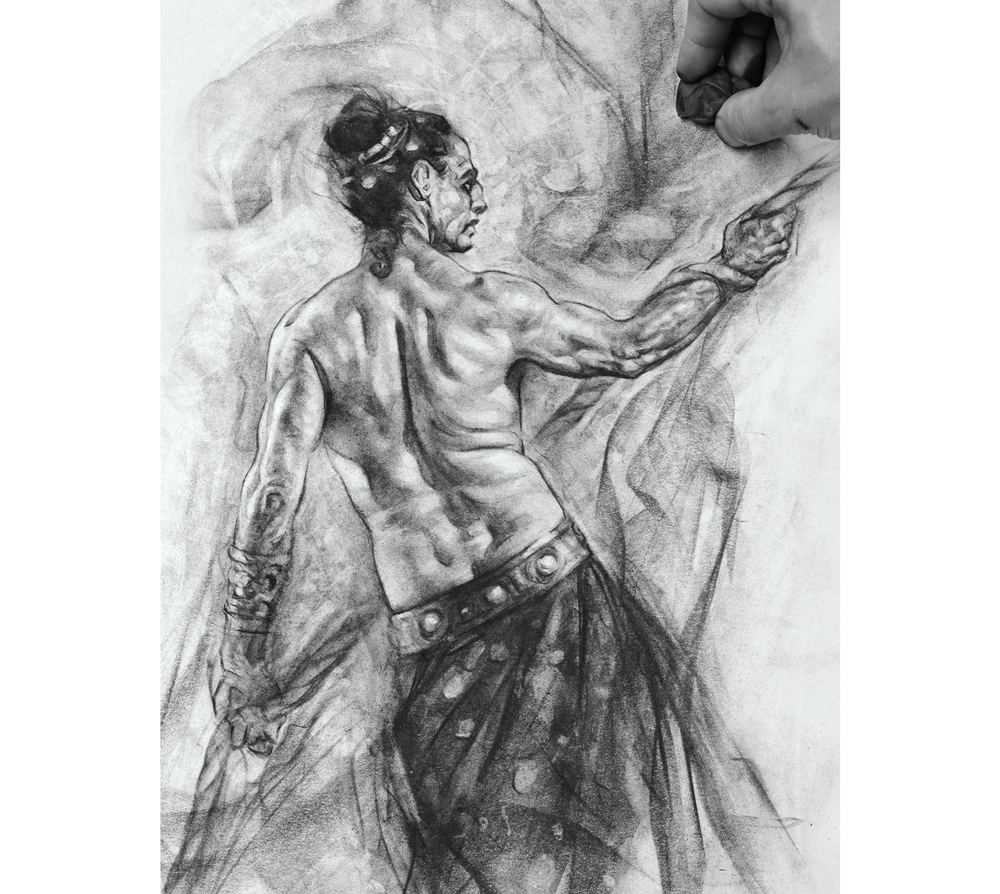
I work an oily sheen into the flesh by contrasting the darks and lights more. I'm left with a drawing more than rendered than I would like, just I've cemented farther noesis of how muscles work and shape-shift into my subconscious, and that makes it all worthwhile.
15. Tug-of-war study canvas

With studies, I go into corking depth identifying muscle landmarks and shapes and in this particular study I'one thousand interested in how all that noesis flows into gesture. If nosotros learn our anatomy well enough information technology'll embed itself into our subconscious and enable usa to draw gesturally.
This article was originally published in consequence 170 of ImagineFX , the world's best-selling magazine for digital artists. Subscribe to ImagineFX (opens in new tab) .
Read more:
- The very all-time lightboxes for tracing
- How to describe a person
- The best pencils: the best mechanical, colouring and drawing
Related articles
faithfulyeatcheed.blogspot.com
Source: https://www.creativebloq.com/how-to/draw-muscles